Block Complexes and Cell List
Copyright © by V. Kovalevsky, last update: October 24, 2011


Let me know
what you think
 Block Complexes
Block Complexes Geometric 2D Cell List
Geometric 2D Cell List Example of a 3D Cell List
Example of a 3D Cell List References
References| Home | Index of Lectures | << Prev | Next >> | PDF Version of this Page |
Block Complexes and Cell ListCopyright © by V. Kovalevsky, last update: October 24, 2011 |
 |
 Let me know what you think |
 Block Complexes Block Complexes Geometric 2D Cell List Geometric 2D Cell List Example of a 3D Cell List Example of a 3D Cell List References References |
Partitions of complexes satisfying certain conditions are known as block complexes.
Consider a partition R of an n-dimensional complex A into k-dimensional subcomplexes
The underlying data structure is called a two-dimensional cell list
| The image | |
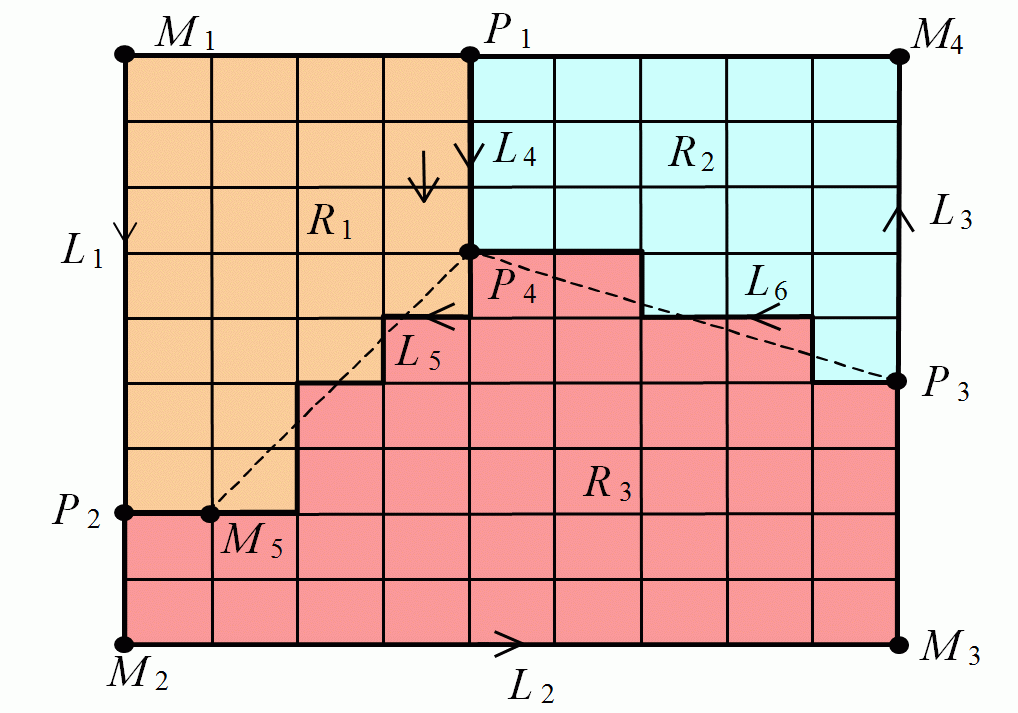 |
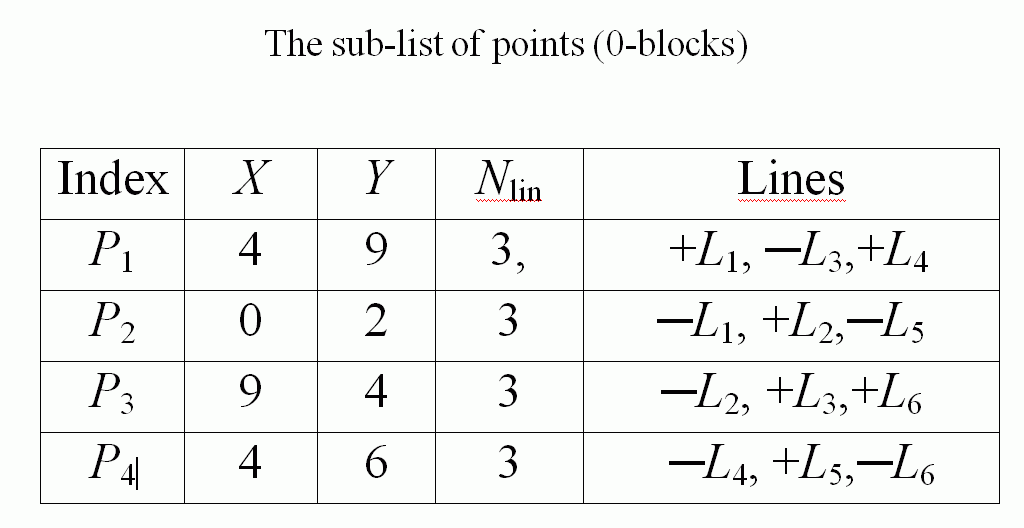 |
| The sub-list of lines (1-block cells) | The sub-list of regions (2-block cells) |
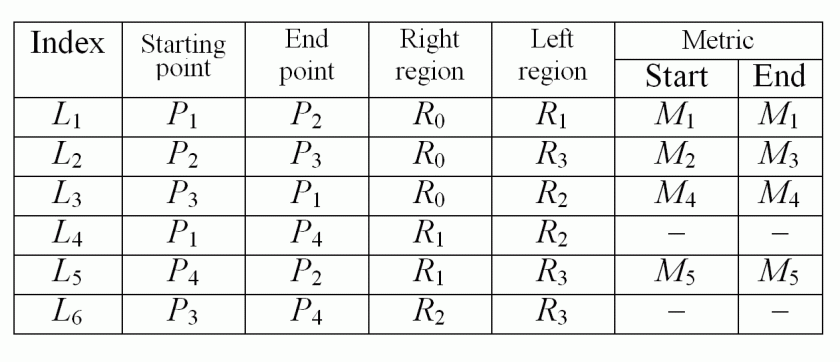 |
 |
The sub-list of the 1-block cells contains the indices of its startng and end points. It also contains the indices of the right and left regions. The last two columns contain indices of the so-called metric points which are no branch points. Their coordinates are saved in the sub-list of metric data (see below). They are vertices of a polygonal line approximating the corresponding segment of the boundary of a region. The metric points are lying between the end points of a line. They are necessary to describe (together with the coordinates of the branch points) geometric features of the image represented by the block complex and serve for the reconstruction of the image. The coordinates can be omitted in a purely topological version of a cell list.
| The metrical sub-list | |
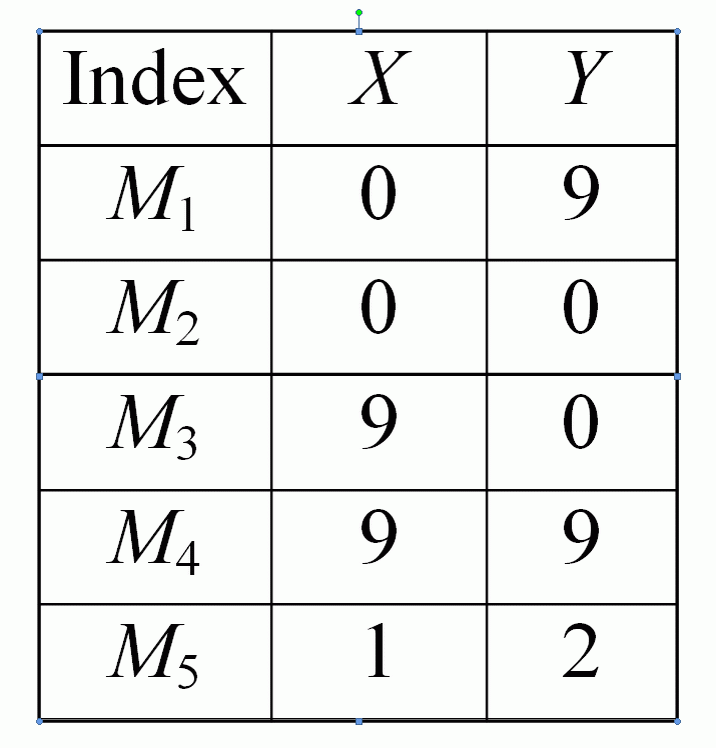 |
It is also possible to make a cell list for a 3D image containing many bodies. If you are interested in details see the refrences [1] and [2]. Here is a simple example
| Small sample with 12 points, 20 lines, 10 faces and 1 body. | |
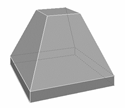 |
Cell List of the small sample with 12 points, 20 lines, 10 faces and 1 body: ----------------- Sub-list of points--------------- Point 1 ( 2; 2; 2) is incident with 3 lines: -1; - 3; - 2; Point 2 (16; 2; 2) is incident with 3 lines: 1; - 7; - 5; Point 3 ( 2;16; 2) is incident with 3 lines: 2; - 8; - 4; Point 4 ( 2; 2; 4) is incident with 4 lines: 3; -13; - 9; -6; Point 5 (16;16; 2) is incident with 3 lines: 4; -10; 5; Point 6 (16; 2; 4) is incident with 4 lines: 6; -14; -12; 7; etc. Points 7 to 12 ----------------- Sub-list of lines (Left, Right from outside) Line 1 StartP= 1 EndP= 1 Left= 2 Right= 1 Line 2 StartP= 1 EndP= 1 Left= 1 Right= 3 Line 3 StartP= 1 EndP= 1 Left= 3 Right= 2 Line 4 StartP= 1 EndP= 3 Left= 1 Right= 5 Line 5 StartP= 1 EndP= 2 Left= 4 Right= 1 Line 6 StartP= 1 EndP= 4 Left= 6 Right= 2 Line 7 StartP= 1 EndP= 2 Left= 2 Right= 4 Line 8 StartP= 1 EndP= 3 Left= 5 Right= 3 Line 9 StartP= 1 EndP= 4 Left= 3 Right= 7 Line 10 StartP= 1 EndP= 5 Left= 4 Right= 5 Line 11 StartP= 1 EndP= 7 Left= 5 Right= 9 Line 12 StartP= 1 EndP= 6 Left= 8 Right= 4 Line 13 StartP= 1 EndP= 4 Left= 7 Right= 6 Line 14 StartP= 1 EndP= 6 Left= 6 Right= 8 Line 15 StartP= 1 EndP= 9 Left=10 Right= 6 Line 16 StartP= 1 EndP= 7 Left= 9 Right= 7 Line 17 StartP= 1 EndP= 9 Left= 7 Right=10 Line 18 StartP= 1 EndP= 8 Left= 8 Right= 9 Line 19 StartP= 1 EndP=11 Left= 9 Right=10 Line 20 StartP= 1 EndP=10 Left=10 Right= 8 ----------------- Sub-list of 10 faces --------------- Face 1 Boundary: (P 2; L - 1) (P 1: L 2) (P 3: L 4) (P 5: L - 5) Face 2 Boundary: (P 4; L - 3) (P 1: L 1) (P 2: L 7) (P 6: L - 6) Face 3 Boundary: (P 3; L - 2) (P 1: L 3) (P 4: L 9) (P 7: L - 8) Face 4 Boundary: (P 2; L 5) (P 5: L 10) (P 8: L -12) (P 6: L - 7) Face 5 Boundary: (P 5; L - 4) (P 3: L 8) (P 7: L 11) (P 8: L -10) Face 6 Boundary: (P 4; L 6) (P 6: L 14) (P10: L -15) (P 9: L -13) Face 7 Boundary: (P 7; L - 9) (P 4: L 13) (P 9: L 17) (P11: L -16) Face 8 Boundary: (P 6; L 12) (P 8: L 18) (P12: L -20) (P10: L -14) Face 9 Boundary: (P 8; L -11) (P 7: L 16) (P11: L 19) (P12: L -18) Face 10 Boundary: (P11; L -17) (P 9: L 15) (P10: L 20) (P12: L -19) ----------------- Sub-list of 1 body --------------- Faces 1, 2, 3, 4, 5, 6, 7, 8, 9, 10.
[1] V.Kovalevsky, Finite Topology as Applied to Image Analysis, Computer Vision, Graphics and Image Processing, v. 46, pp. 141-161, 1989..
[2] V. Kovalevsky: Geometry of Locally Finite Spaces, Monography, Berlin 2008.
Download: Print version| top of page:
|
Last update: October 24, 2011